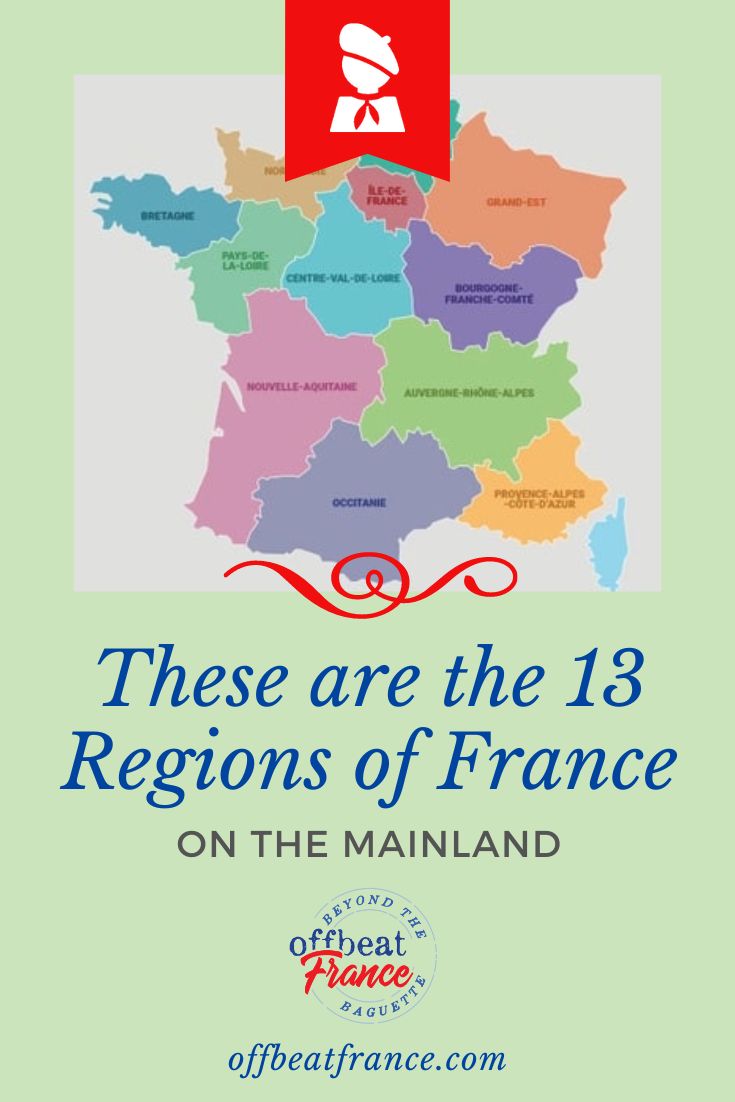Unsure about your French table manners? Click Here to download > > How to avoid these 10 food etiquette mistakes !
- Home ›
- Destinations ›
- Regions of France
This List Of Regions In France Will Help You Plan Your Trip
Updated 22 March 2024 by Leyla Alyanak — Parisian by birth, Lyonnaise by adoption, historian by passion
France changed the names and shapes its regions in 2016, confusing everyone. We had to relearn our geography! Here's what the new regions look like – this information will help when you're planning your next France itinerary.
Like all countries, France is divided up into bits and pieces. It looks something like this:
- 18 broad regions (13 of which are in Europe and 5 which are overseas regions of France)
- 101 different departments – what you would call states or provinces; each has a department number (often seen on your car number plate)
- thousands of cities, towns, villages and hamlets
Each France region has its specialties (many of them culinary) and even small towns and villages have things that make them stand out.
Understanding my country's structure will help you uncover what we are like as a people and just how diverse and large France really is.
France is, in fact, more than twice the size of the United Kingdom and 1.5 times the size of Germany. Of course size comparisons pale when we talk about the US – we are roughly the same size as Texas (and equally modest).
List of regions in France
- Auvergne-Rhône-Alpes (the Alps, edging into the center of France)
- Bourgogne-Franche-Comté (Burgundy)
- Bretagne (Brittany)
- Centre-Val de Loire (Eastern Loire Valley)
- Corse (Corsica)
- Grand Est (the Northeast)
- Hauts-de-France (the North)
- Île-de-France (Paris and environs)
- Normandie (Normandy)
- Nouvelle-Aquitaine (Bordeaux, down to the Spanish border)
- Occitanie (the South and Pyrenees)
- Pays de la Loire (Western Loire Valley)
- Provence-Alpes-Côte d'Azur (Provence and the Riviera)
NOTE: Pages on this site may contain affiliate links, which support this site. See full Privacy Policy here.
List of regions in France
How many regions in France?
It's not an easy question: we used to have 22, but then everything changed.
The great 2016 merger
Today, France has 18 administrative regions:
- 13 metropolitan regions in mainland France
- 5 overseas regions or territories spread around the Caribbean and the Indian Ocean, the result of colonialism
➽ This article will not cover the overseas departments of Guadeloupe Island, Martinique Island, Guyane (French Guiana or Guyana), Mayotte or La Réunion, only on the 13 "metropolitan" regions.
Here, we will look at those areas of France located on the mainland (the island of Corsica may be physically separate from the mainland , but it is considered part of metropolitan France, "la métropole".)
These regional boundaries reflect a relatively recent (2016) decision by the French National Assembly to reduce the number of regions from 22 to the present 13 new super-regions.
This was not a painless process, and many parts of France felt disenfranchised after they lost historical names they had held for centuries to make way for larger administrative entities with a new name. As often happens, boundaries were shuffled in ways that sometimes ignored history.
In case you're curious, you can compare the names of the old regions with the new ones here.
France's former regions
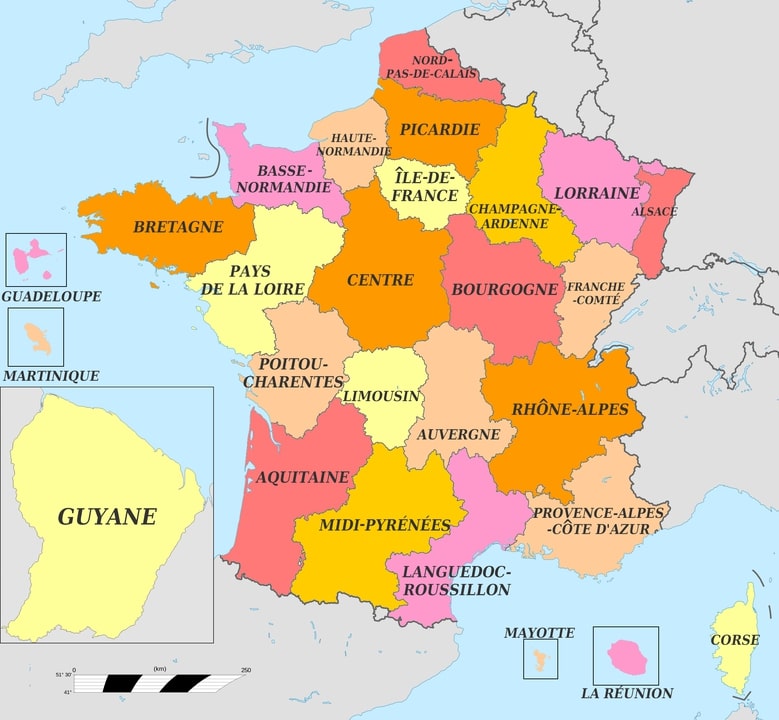 France's former regions prior to 2016. Map by Gregjarlot via Wikimedia Commons CC BY-SA 4.0
France's former regions prior to 2016. Map by Gregjarlot via Wikimedia Commons CC BY-SA 4.0The designations of the former regions remain in everyday culture, however.
For example, the area formerly called Alsace, or Alsace-Lorraine, is still often called by its old name, even though it is now part of the Grand-Est region. No one says they're going to visit the "Grand-Est" – they would say, "I'm going to Alsace."
Here's what France's regions look like today, after the 2016 change.
French regions after 2016
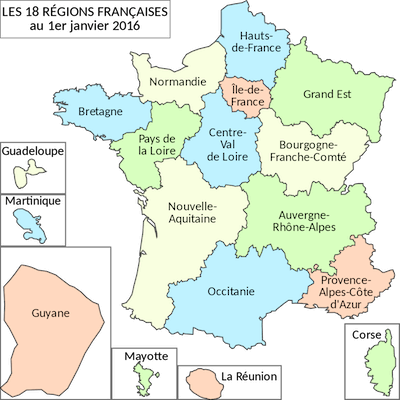 Map of French regions by Monsieur Fou, CC BY-SA 4.0, via Wikimedia Commons
Map of French regions by Monsieur Fou, CC BY-SA 4.0, via Wikimedia CommonsWhat exactly is a region?
A region would be, say, like a grouping of US states: the Southwest, for example, or New England, except that our areas of France are formal – in other words, these are administrative entities with a legal status and a capital.
The 18 France regions – some might liken them to French provinces – are broken down into 101 French departments, including those located overseas. As a child I was made to learn the names of all the departments, but I don't remember them all – my excuse is that a lot of them have changed names!
The following regions of France list contains all the "mainland" regions, with their prefecture (capital city), their departments, and a list of the UNESCO World Heritage Sites you'll find in each, just to give you a bit of local flavor.
They're listed alphabetically – no playing favorites here!
And if it's food you're after, here are our culinary specialties, by region.
Do you need any guidebooks to help you plan your trip?
Here are three of the most recent:
France's metropolitan regions
Each of these regions has a capital, or "prefecture", which acts as its administrative seat. Below I've also listed the "départements" contained in each region, and the listed UNESCO World Heritage sites.
Auvergne-Rhône-Alpes
Until a few years ago, the Auvergne and the Rhône-Alpes were two different regions, which were combined during the "great merger" of 2016.
This is a mountainous area, containing most of the Alps, the central volcanic region, and a large part of the Massif Central, along with a significant portion of the Rhone Valley. It borders on Lake Geneva, and also happens to be my own region, where I live.
It covers 13% of France (the size of Ireland), and is the country's most populated. It is France's leading gastronomic and industrial region, and has the largest skiing surface in the world.
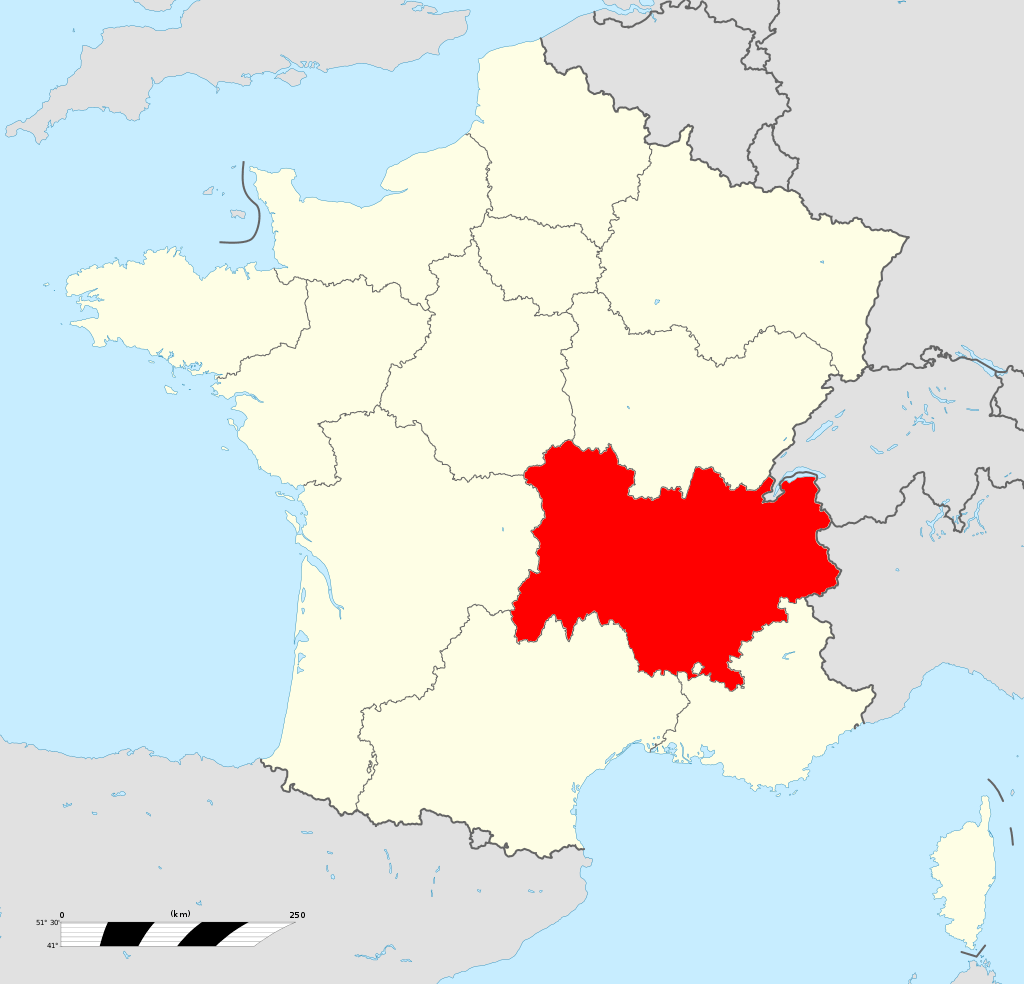
Prefecture: Lyon
Includes the departments of: Ain (01), Allier (03), Ardèche (07), Cantal (15), Drôme (26), Isère (38), Loire (42), Haute-Loire (43), Puy-de-Dôme (63), Rhône (69), Savoie (73), Haute-Savoie (74)
UNESCO World Heritage Sites in Auvergne-Rhone-Alpes
- Historic site of Lyon – known for its gastronomy and its rich history and architecture and giant murals, from the secret traboule passageways of Old Lyon all the way to Croix Rousse hill. Included in UNESCO's protection are the Roman ruins of Lugdunum.
- Prehistoric pile dwellings around the Alps – they were built between 5000 to 500 BCE on the edges of waterways, and many remains are now underwater (also located in Burgundy)
- Decorated Cave of Pont d’Arc, known as Grotte Chauvet-Pont d’Arc, Ardèche – contains some of the world's best-preserved cave paintings – and the rest of the Ardeche is wild and green
- Chaine des Puys - Limagne fault tectonic arena – volcanoes provide evidence of tectonic action
- Great Spa Towns of Europe – includes the town of Vichy, one of 11 European spa towns in 7 countries
Other sights worth seeing
- Annecy and its lake
- The towns of Evian-les-Bains and Aix-les-Bains
- The Alps
Bourgogne-Franche-Comté
This region is made up of two very distinct former regions. Burgundy, once a separate country ruled by the Dukes of Burgundy, and Franche-Comté.
This accounts for the large number of remarkable historical sites in the region, which, by the way, is also home to the wines of Burgundy (and of the lesser-known Jura).
The region is also incredibly green and filled with wonderful natural landscapes, a paradise for outdoor sports both in summer and winter, and doted with plenty of mountains – the Vosges, the Jura Mountains, and parts of the Massif Central.
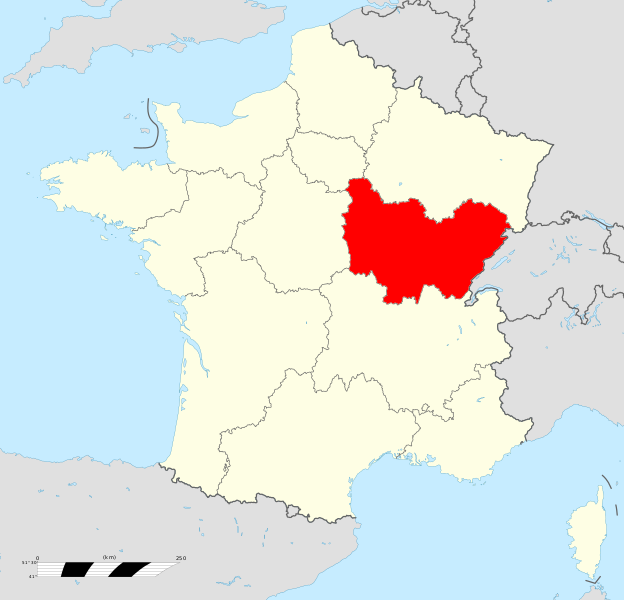
Prefecture: Dijon
Includes the departments of: Côte-d'Or (21), Doubs (25), Jura (39), Nièvre (58), Haute-Saône (70), Saône-et-Loire (71), Yonne (89), Territoire de Belfort (90)
UNESCO World Heritage Sites in Bourgogne-Franche-Comté
- Cistercian Abbey of Fontenay – founded in the early 12th century and very much intact
- Basilica of St. Mary Magdalene at hill at Vézelay – Burgundian Romanesque place of pilgrimage and monastic church
- Sainte-Croix-Notre-Dame church of La Charité-sur-Loire – one of several sites listed as part of the French routes to Santiago de Compostela
- From the Great Saltworks of Salins-les-Bains to the Royal Saltworks of Arc-et-Senans, the Production of Open-pan Salt – both the architecture of the Royal Saltworks and the salt-mining technique are recognized, along with the 18th-century pipeline carrying brine between the two for 21km
- Prehistoric pile dwellings around the Alps – they were built from about 5000 to 500 BC on the edges of water, and many remains are now underwater (also located in Auvergne-Rhône-Alpes)
- The Climats, terroirs of Burgundy – certain plots and parcels of vineyards which produce Burgundy wine
Other sights worth seeing
Bretagne
Bretagne, or Brittany, is famous for legends, and has more than 3000 standing megaliths scattered throughout, possibly the world's largest collection.
Its Celtic culture is quite different from that of the heart of France, and its nature diverse, with tiny fishing villages clinging to beaches and rocky coasts, and a multitude of islands, all of which makes it an outstanding destination for a visit.
This is also the land of the famous crêpe, as you probably know...
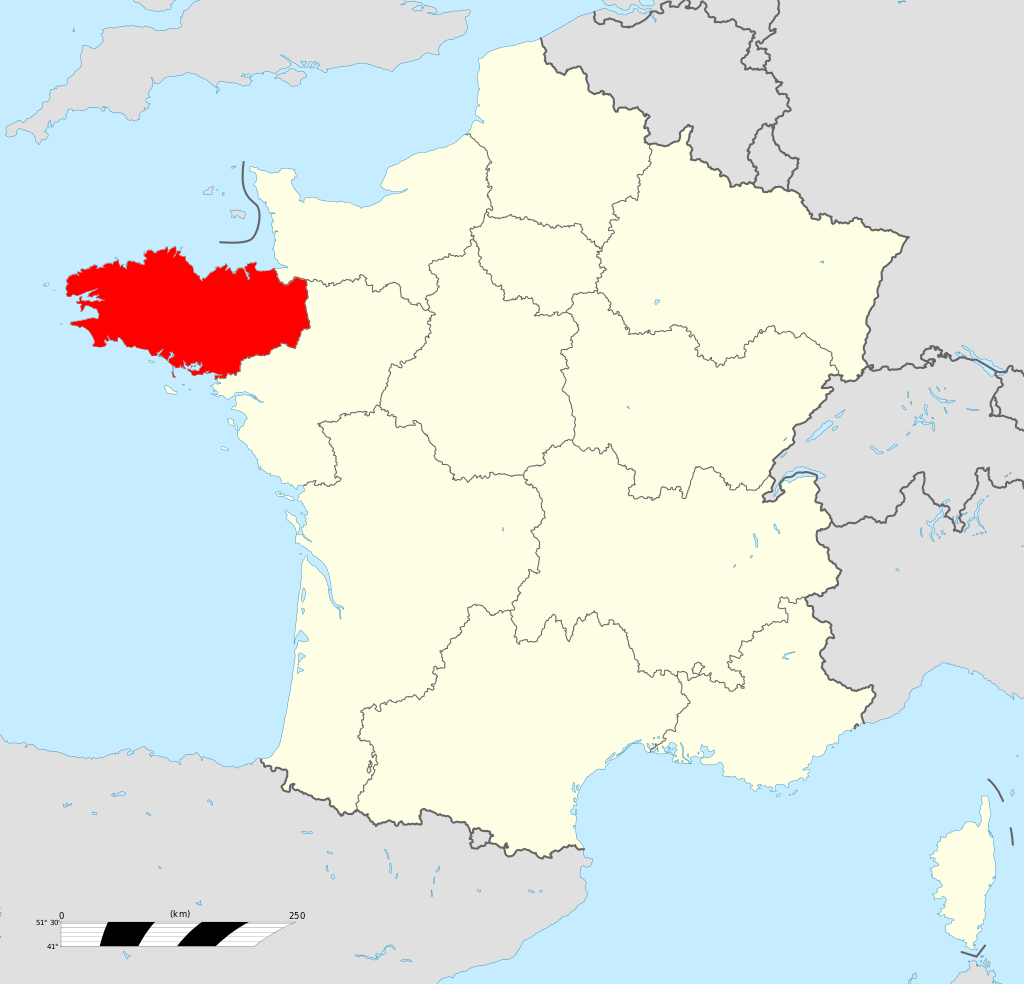
Prefecture: Rennes
Includes the departments of: Côtes-d'Armor (22), Finistère (29), Ille-et-Vilaine (35), Morbihan (56)
Until recently, Brittany was the only French region without a UNESCO World Heritage Site, but this was rectified with the inclusion of the menhirs and dolmens (think Asterix) at Carnac. It also boasts a multitude of beaches, quaint fishing villages and dramatic cliff backdrops. This is also where you'll come for authentic crêpes!
Centre-Val de Loire
This region is probably well known to you: located in central France, it is the home of such beloved chateaux as Chambord, Chenonceau, Chinon or Cheverny. It also encompasses such historic provinces as the Berry and is famous for both its pinot noir and its white wines.
It is crossed by the Loire River, one of France's main rivers as well as its longest river. The region is so easy to reach by public transport that many people commute from here to Paris.
Conversely, if you're visiting Paris, you can easily take a day trip to the Loire Valley and enjoy some of the country's best places for history and architecture buffs. (You can also reach a number of Loire castles by train – you don't need a car.)
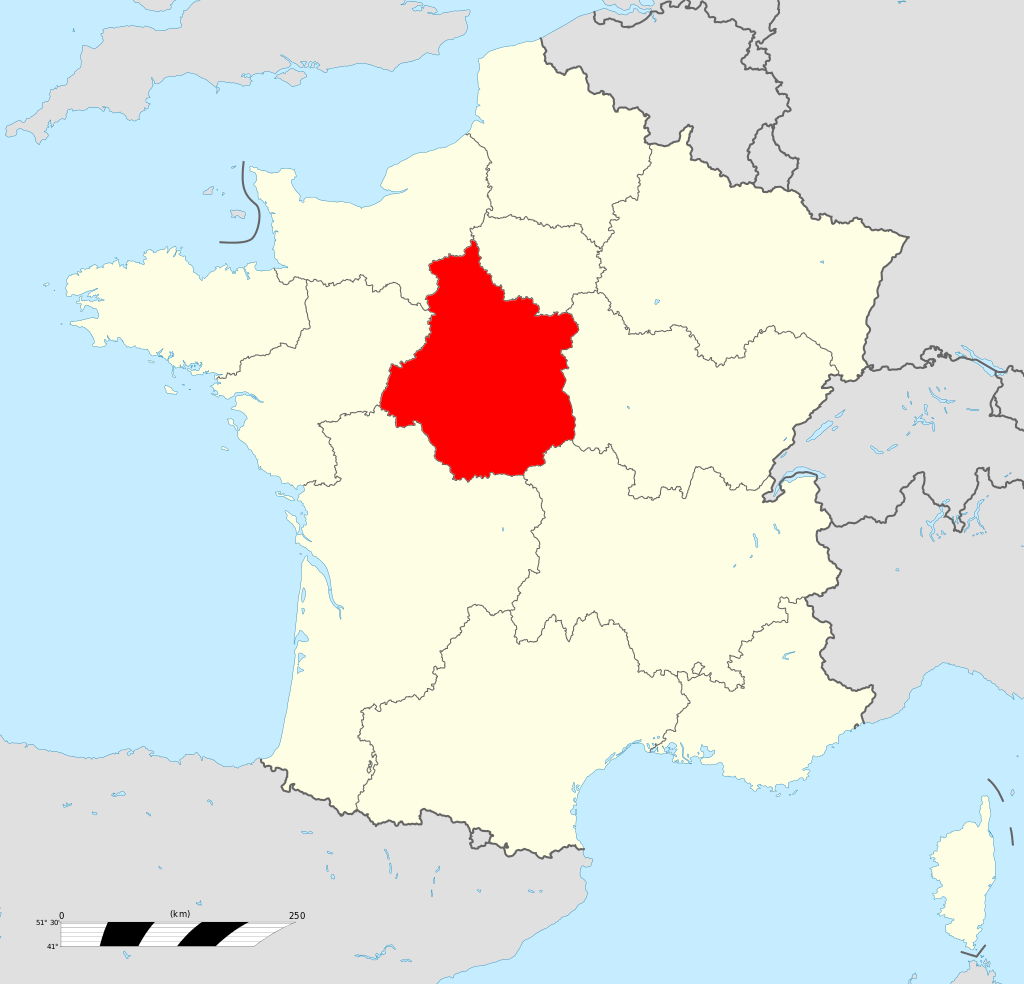
Prefecture: Orléans
Includes the departments of: Cher (18), Eure-et-Loir (28), Indre (36), Indre-et-Loire (37), Loir-et-Cher (41), Loiret (45)
UNESCO World Heritage Sites in Centre-Val de Loire
- Bourges Cathedral – highly decorated portals and major stained glasswork
- Chartres Cathedral – looks much as it did in the 13th century, with beautiful stained glass and flying buttresses, a Gothic masterpiece
- The Loire Valley between Sully-sur-Loire and Chalonnes – stretches into the Pays de la Loire region next door and famous for its chateaux
Confused by all the different Loire regions/departments/rivers? I've tried to make it a bit clearer!
Corse (Corsica)
Corsica is famous as the home of Napoleon Bonaparte, of course, but also for its stunning scenery, which makes it a favorite Mediterranean Sea destination for locals and foreigners alike.
It is also one of French regions with a distinct regional identity and a pan European history.
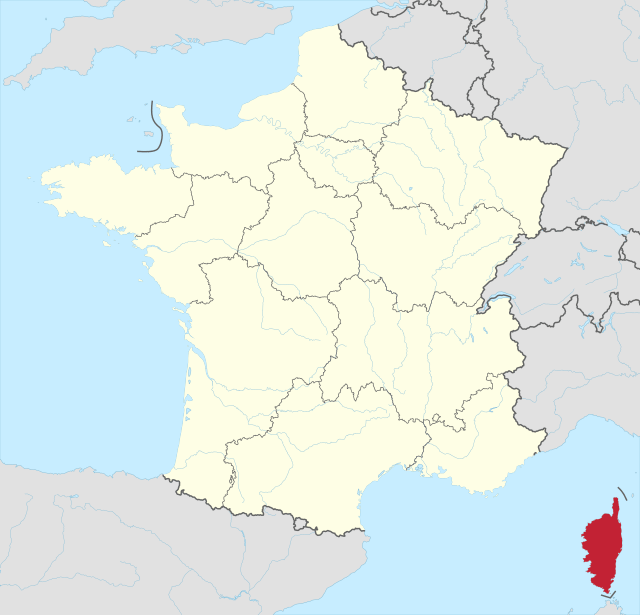
Prefecture: Ajaccio
Includes the departments of: Haute-Corse (2B), Corse-du-Sud (2A)
UNESCO World Heritage Sites in Corsica
- Gulf of Porto: Calanche of Piana, Gulf of Girolata, Scandola Reserve – plenty of wildlife, clear waters and inaccessible caves result in rich marine life
Other sights worth seeing
- The Bonaparte Family House in Ajaccio, now a museum
Grand-Est
This region is a complicated mixture of areas which have played an important role in French history, such as the former Alsace-Lorraine, whose loss to Germany was one of the causes of the First World War.
Part of this region was once known as Champagne-Ardennes, and as you can guess, it is home to the vineyards of Champagne.
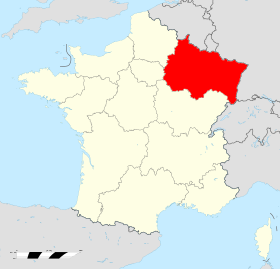
Prefecture: Strasbourg
Includes the departments of: Ardennes (08), Aube (10), Marne (51), Haute-Marne (52), Meurthe-et-Moselle (54), Meuse (55), Moselle (57), Bas-Rhin (67), Haut-Rhin (68), Vosges (88)
UNESCO World Heritage Sites in the Grand Est
- Cathedral of Notre-Dame, Former Abbey of Saint-Remi, and Palace of Tau, Reims – masterpieces of Gothic art
- Place Stanislas, Place de la Carrière, and Place d'Alliance in Nancy – harmonious urban landscape and an outstanding example of 18th-century town planning
- Strasbourg - From the Grande Île to the Neustadt – the Grande Île is Strasbourg's historical center, while Neustadt is the area built by the Germans
- Champagne Hillsides, Houses and Cellars – various elements and places that have contributed to the production and sale of champagne
Other sights worth seeing
- Art Nouveau buildings in Nancy
- Chateau de Cirey, where Voltaire lived and loved
- The Walled City of Langres
Hauts-de-France
Hauts-de-France is the north of France, and is a popular region for those interested in the battlefields of World Wars I and II. The main city, Lille, is home to the Braderie de Lille, Europe's largest and most famous flea market.
This is also where you'll find the beaches of the Opal Coast, known for its marshes and dunes and white chalk cliffs, similar to those of Dover across the Channel.
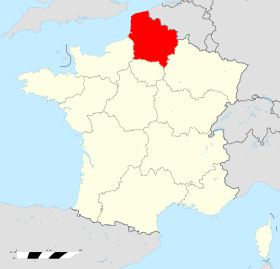
Prefecture: Lille
Includes the departments of: Aisne (02), Nord (59), Oise (60), Pas-de-Calais (62), Somme (80)
UNESCO World Heritage Sites in the Hauts-de-France
- Amiens Cathedral – one of the largest 13th-century Gothic cathedrals, the crowning glory of the city of Amiens
- Nord-Pas de Calais Mining Basin – coal has been extracted for three centuries in the area, which highlights an important period in European industrialization
- Belfries of Belgium and France – 23 in northern France are protected
Other sights worth seeing
- Louvre-Lens museum in Lens
Île-de-France
Ile de France is the home of Paris, the country's capital and its largest city.
Often called the City of Light, it is the main attraction for many of those visiting France.
Other than Paris, the Île-de-France region is home to the chateaux of Versailles, Fontainebleau and Vaux-le-Vicomte, among others.
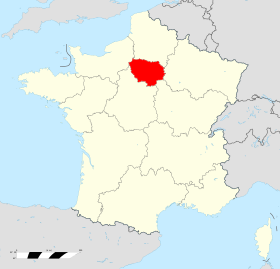
Prefecture: Paris
Includes the departments of: Paris (75), Seine-et-Marne (77), Yvelines (78), Essonne (91), Hauts-de-Seine (92), Seine-Saint-Denis (93), Val-de-Marne (94), Val-d'Oise (95)
UNESCO World Heritage Sites in Île-de-France
- Palace and Park of Fontainebleau – a royal residence south of Paris and one of the largest royal castles
- Palace and Park of Versailles – adopted by Louis XIV as the royal residence, the complex is a symbol of power and of unparalleled beauty
- Paris, Banks of the Seine – both banks are on the list, and we know just how gorgeous they are
- Provins, Town of Medieval Fairs – medieval architecture, ramparts, inscriptions in underground tunnels, and once hosted a major annual trade fair
Other sights worth seeing
- Secrets of the Eiffel Tower
- Disneyland Paris, for all ages
Normandie
Normandy is well known for its medieval castles and gothic cathedrals, as well as its World War II landing beaches and historical remains. It's also home to stunning cliffs and wonderful beaches, not to mention picturesque villages and some of the best food in France.
Lower Normandy, of course, is known for Mont Saint-Michel, an island just off the coast and crowned with an abbey, making for one of the most interesting places in France (and one of the more challenging to reach).
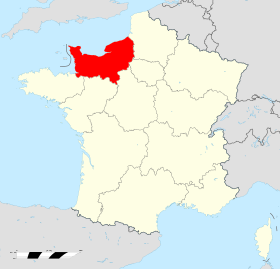
Prefecture: Rouen
Includes the departments of: Calvados (14), Eure (27), Manche (50), Orne (61), Seine-Maritime (76)
UNESCO World Heritage Sites in Normandy
- Le Havre, the City Rebuilt by Auguste Perret – the city was heavily bombed during World War II and rebuilt by August Perret, a pioneer in the use of reinforced concrete
- Mont Saint-Michel and its Bay – well defended at high tide, when it is surrounded by water; more than 60 of its buildings are national monuments, and it is an important medieval Christian site
Other sights worth seeing
- D-Day beaches of Normandy
- The Bayeux Tapestry
- Rouen Cathedral
Nouvelle Aquitaine
This historic region (remember Eleanor of Aquitaine?) roughly encompasses the southern half of western France and faces the Atlantic Ocean. It is known as Europe's leading agricultural region when it comes to economic development and, of course, is also the region of Bordeaux wine and cognac.
Many visitors also beat a path to the Dordogne, with its markets and authentic villages, and to the Basque hinterland, for those who seek something culturally different from the rest of France.
Nouvelle-Aquitaine is the largest of the French regions.
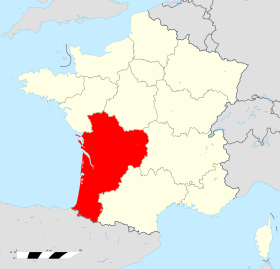
Prefecture: Bordeaux
Includes the departments of: Charente (16), Charente-Maritime (17), Corrèze (19), Creuse (23), Dordogne (24), Gironde (33), Landes (40), Lot-et-Garonne (47), Pyrénées-Atlantiques (64), Deux-Sèvres (79), Vienne (86), Haute-Vienne (87)
UNESCO World Heritage Sites in Nouvelle-Aquitaine
- Abbey Church of Saint-Savin-sur-Gartempe – a Roman Catholic Romanesque church with beautifully preserved 11th-12th century murals
- Bordeaux, Port of the Moon – the historic center of the city, for its outstanding urban architecture along the moon-shaped bend in the Garonne River
- Jurisdiction of Saint-Émilion – includes the medieval city of Saint-Émilion, the seven villages that surround it and their vineyards
- Prehistoric Sites and Decorated Caves of the Vézère Valley – 15 prehistoric sites around Les Eyzies-de-Tayac-Sireuil, often called the "Capital of Prehistory"
- Cordouan Lighthouse – the 10th tallest lighthouse in the world, located at sea, near the estuary of the Gironde River (plenty of sites in this region in France!)
Other sights worth seeing
- The city of Bordeaux
- The French Basque country
- Bayonne
- The Dune du Pilat and Arcachon Bay
Occitanie
This is a culturally and historically rich region, and highly diverse, from the Pyrenees Mountains to its coastal beaches.
High in color and tastes, this is southern France at its best, with plenty of sunshine and bountiful orchards and a favorite vacation destination of both foreign and French people.
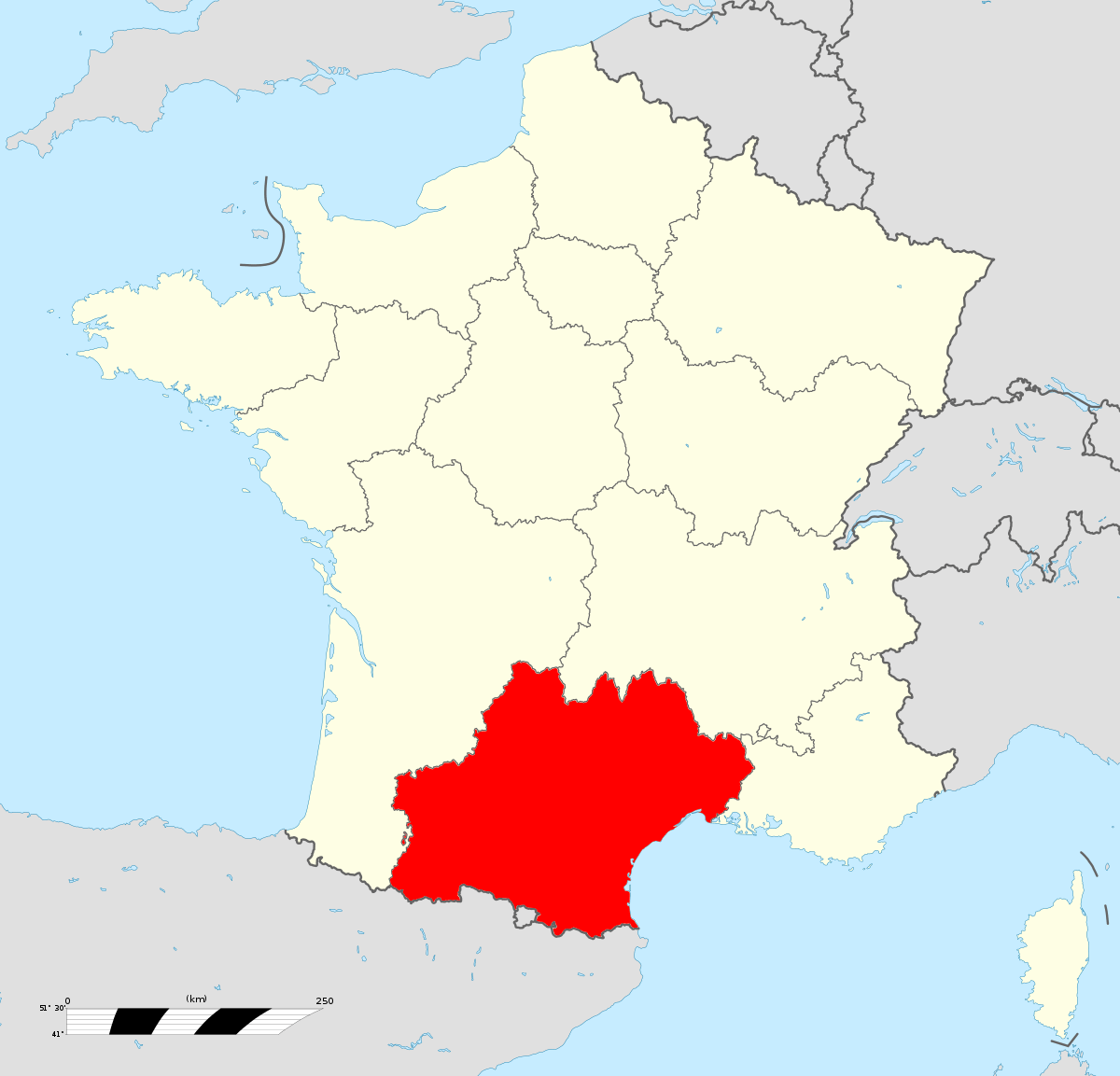
Prefecture: Toulouse
Includes the departments of: Ariège (09), Aude (11), Aveyron (12), Gard (30), Haute-Garonne (31), Gers (32), Hérault (34), Lot (46), Lozère (48), Hautes-Pyrénées (65), Pyrénées-Orientales (66), Tarn (81), Tarn-et-Garonne (82)
UNESCO World Heritage Sites in Occitanie
- Canal du Midi – at 240 km in length it is one of the most important 17th-century constructions in France
- The Causses and the Cévennes – mountains and valleys with strong traditions of pastoralism and where remnants of transhumance still taking place
- Episcopal City of Albi – medieval architecture on the banks of the Tarn River dating back to the 10th century
- Pont du Gard (Roman Aqueduct) – an ancient Roman aqueduct bridge and the only three-story antique bridge still standing, the most visited of France's Gallo-Roman ruins
- Historic Fortified City of Carcassonne – stunning fortified medieval citadel, with massive defences and a Gothic cathedral, restored by Viollet-le-Duc
- Pyrénées - Mont Perdu – straddles the Spanish border, where the summit is located, but then extended into France
Other sights worth seeing
- Castles of Cathar Country
- Toulouse, the Pink City
- Roman ruins of Nîmes
- The stunning Camargue wetlands and its flamingoes
- The city of Montpellier
Pays de la Loire
Not to be confused with the Centre-Val-de-Loire region, this is the "other" Loire, further downriver from its near-namesake and also full of Renaissance chateaux. (You can find out about France's different uses of the word "Loire" here.)
This region, however, encompasses part of what used to be considered Brittany, such as the city of Nantes. There are famous medieval reenactments in the region, not surprising given its history.
The Pays de la Loire is steeped in history but also filled with beautiful natural sites, such as the Granite Coast. It's perfect for lovers of seafood and white wine, explorers of magnificent chateaux and beach aficionados.
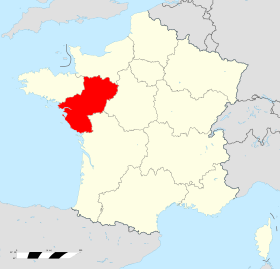
Prefecture: Nantes
Includes the departments of: Loire-Atlantique (44), Maine-et-Loire (49), Mayenne (53), Sarthe (72), Vendée (85)
UNESCO World Heritage Sites in the Pays de la Loire
- The Loire Valley between Sully-sur-Loire and Chalonnes – also stretches next door into the Centre-Val de Loire – this is the region of France with all the chateaux!
Other sights worth seeing
- Salt Marshes of the Guérande
- The Puy du Fou for medieval reenactments
Provence-Alpes-Côte d'Azur
Provence and the French Riviera need very little introduction, from the hilltop villages of the Luberon to the beaches and red carpet of Cannes or the lavender fields that burst into flower each summer.
This is a land graced by nature, from its mountains all the way down to its crystal blue seas. The vistas are unimaginable, and the villages exquisite, with their cobblestones and flowers.
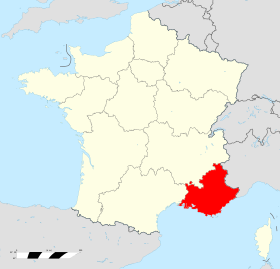
Prefecture: Marseille
Includes the departments of: Alpes-de-Haute-Provence (04), Hautes-Alpes (05), Alpes-Maritimes (06), Bouches-du-Rhône (13), Var (83), Vaucluse (84)
UNESCO World Heritage Sites in PACA
- Arles, Roman and Romanesque Monuments – the area in the center of Arles which contains a multitude of monuments and was extensively painted by van Gogh
- Historical center of Avignon: Papal Palace, Episcopal Ensemble and Avignon Bridge – architecturally important, and the seat of Western Christianity during the 14th century
- Roman Theatre and its Surroundings and the "Triumphal Arch" of Orange – one of the best-preserved Roman theaters, and the arch is a beautiful and rare Roman example (France has many Roman ruins)
- Nice, Winter Resort Town of the Riviera – the French Riviera is a cosmopolitan mix, the result of many successive waves of winter visitors and famous for its mild winter climate
Other sights worth seeing
- Barthelasse Island, to get the best view of Avignon Bridge
- The wonderful antique shops of Isle-sur-la-Sorgue
- Grasse, World Capital of Perfume
FAQ: List of Regions in France
Why are there 13 regions in France?
There used to be 22 regions in metropolitan France but in an effort to reduce costs and limit bureaucratic duplication, these were reduced to 13 in 2016.
How are France's regions governed?
Each region is administered by a Regional Council made up of regional council members and presided by a Regional President elected by them.
What makes up a region?
Each region has a regional capital and is made up of a number of administrative departments, for a total of 101 departments for 18 regions, 13 in continental France and 5 French overseas regions.
Before you go...
I hope this list of regions in France will help you plan your trip to France! As you've seen, we are an incredibly diverse land and, I hope, interesting enough to keep you coming back!
